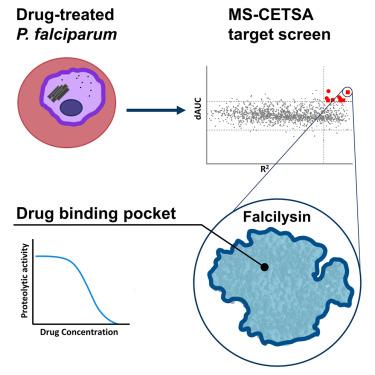Cell Chemical Biology ( IF 8.6 ) Pub Date : 2024-04-08 , DOI: 10.1016/j.chembiol.2024.03.002 Grennady Wirjanata , Jianqing Lin , Jerzy Michal Dziekan , Abbas El Sahili , Zara Chung , Seth Tjia , Nur Elyza Binte Zulkifli , Josephine Boentoro , Roy Tham , Lai Si Jia , Ka Diam Go , Han Yu , Anthony Partridge , David Olsen , Nayana Prabhu , Radoslaw M. Sobota , Pär Nordlund , Julien Lescar , Zbynek Bozdech

|
Identification of new druggable protein targets remains the key challenge in the current antimalarial development efforts. Here we used mass-spectrometry-based cellular thermal shift assay (MS-CETSA) to identify potential targets of several antimalarials and drug candidates. We found that falcilysin (FLN) is a common binding partner for several drug candidates such as MK-4815, MMV000848, and MMV665806 but also interacts with quinoline drugs such as chloroquine and mefloquine. Enzymatic assays showed that these compounds can inhibit FLN proteolytic activity. Their interaction with FLN was explored systematically by isothermal titration calorimetry and X-ray crystallography, revealing a shared hydrophobic pocket in the catalytic chamber of the enzyme. Characterization of transgenic cell lines with lowered FLN expression demonstrated statistically significant increases in susceptibility toward MK-4815, MMV000848, and several quinolines. Importantly, the hydrophobic pocket of FLN appears amenable to inhibition and the structures reported here can guide the development of novel drugs against malaria.































 京公网安备 11010802027423号
京公网安备 11010802027423号